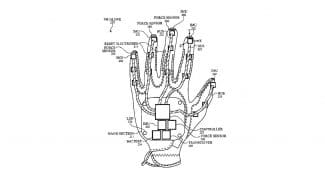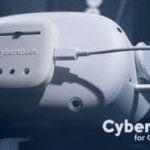Apple was granted a patent for a “VR glove capable of measuring the movement of individual finger and thumb bones.”
The patent application was filed in 2018 but granted on December 29, 2020, and first reported by Patently Apple.
While companies patent ideas all the time that never see actual deployment, the filings still offer a rare insight into the concepts being considered by some of the most forward-thinking people at a given organization. Apple in particular is well-known for patenting a wide range of concepts that don’t make it into shipping products.
Below are the Background and Summary sections of patent #10,877,557 originally filed by Apple on August 28, 2018 with notable sections bolded:
BACKGROUND OF THE DISCLOSURE
Virtual reality (VR) technology can be used for many applications such as military training, educational learning, and video games. VR technology can use one or more electronic devices to simulate a virtual environment and the user’s physical presence in that virtual environment. One type of VR technology is augmented reality (AR) technology, where the user’s real environment can be supplemented with computer-generated objects or content. Another type of VR technology is mixed reality (MR) technology, where the user’s real environment and the virtual environment can be blended together.
VR/AR/MR technology can be simulated using one or more electronic devices. One electronic device can be a VR headset, where the user can use the VR headset to see the simulated virtual environment. As the user moves his or her head to look around, a display included in the headset can update to reflect the user’s head movement. Another electronic device can include one or more cameras. The one or more cameras can be used to capture the user’s real environment in AR technology and/or can be used for positional tracking. Yet another electronic device can include VR gloves. VR gloves can be worn over the user’s hands and can allow the user to touch, feel, and hold virtual objects in real-time. VR gloves capable of accurately detecting the positions and motions of the user’s hands and fingers without occlusion may be desired.
SUMMARY OF THE DISCLOSURE
This disclosure relates to a VR glove capable of measuring the movement of individual finger and thumb bones. The VR glove can include a plurality of inertial measurement units (IMUs) to track the movement of one or more finger and/or hand sections. The IMUs can include one or more motion sensors, such as a gyroscope and an accelerometer, for measuring the orientation, position, and velocity of objects (e.g., finger bones) that the IMU can be attached. An IMU can be located proximate to a finger (or thumb) bone and can measure the inertial motion of the corresponding bone. In some examples, the VR glove may include magnetometers to determine the direction of the geo-magnetic field. The VR glove can also include one or more other electronic components, such as a plurality of electrodes for sensing the heading, enabling capacitive touch, and/or contact sensing between finger tips. The VR glove can also include force sensors, actuators for haptic feedback, temperature sensors, and heaters. The VR glove can further include logic such as an on-board controller, a connector, a transceiver, a battery, and the like. One or more buses can be used to carry signals between the electronic components to, e.g., the on-hand controller. The VR glove can be a fabric glove where one or more (e.g., all) electronics components can be knitted or woven into the glove. In some examples, the fabric can be stitched together using conductive threads. Examples of the disclosure can further include detecting movement of the glove without using magnetometers by comparing the motion detected by the IMUs with local frame(s). Heading initialization can include rotation optimizers, and heading correction can include detecting irregularities (e.g., collision, rotations, etc.) of the nodes associated with the IMUs.
So there you have it — a VR Glove patent from Apple that goes so far as to mention the potential of “haptic feedback.”






